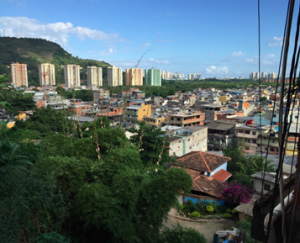In Brazil, residents of informal communities are disproportionately affected by the Zika epidemic and ongoing threats from other mosquito-borne illnesses. Underdeveloped sanitation systems and poorly maintained streets are some of the many factors that contribute to mosquito reproduction and increase risk of infection among residents of informal communities. So what can be done to help this public health problem?

The Rio das Pedras, community in Rio de Janeiro, Brazil.
Under the leadership of Dr. Gina Lovasi, the Built Environment and Health Research Group (BEH) completed a Community Needs Assessment for Rio das Pedras, home of the third largest informal community in Rio de Janeiro, Brazil. Along with interviews, collection of water and saliva samples, and Global Positioning System based mobility monitoring, the BEH study team conducted a field study of neighborhood environmental conditions using a structured neighborhood audit tool and collected more than 4,000 geotagged photos.

Mosquito breeding heaven – construction debris and garbage and litter make for abundent mosquito breeding and resting locations
Now, BEH has teamed up with the Data Science Institute at Columbia University and the Oswaldo Cruz Foundation in Rio de Janeiro, Brazil to lay a foundation for creating and disseminating knowledge and technologies with the potential to strengthen the Brazilian response to the ongoing Zika Virus crisis. Using the images collected from the Community Needs Assessment, trained auditors are taking a look at the photos from a ‘mosquito’s eye view’ to identify objects that serve as suitable mosquito breeding sites. These annotated photos will be used to train a machine learning image analysis algorithm built by the Data Science Institute to identify areas that represent a high, moderate/indeterminate, or low level of concern for mosquito breeding sites.

